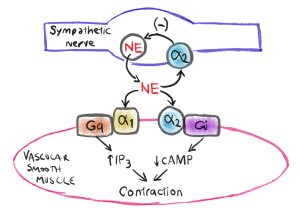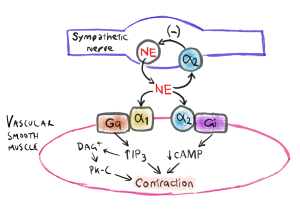2.10 Alpha-Receptor Pharmacology
John Smithson
Cardiovascular Pharmacology – Alpha-Receptor Pharmacology
In this topic we will focus on the pharmacological action of alpha antagonists and agonists.
Learning Outcomes
Be able to:
- List the two types of alpha receptors, where they are found and their action.
- Describe the pharmacological action of alpha agonists
- Describe the mechanism of action for clonidine
- Describe the pharmacological action of alpha antagonists.
Introduction
There are two main types of alpha-receptor: alpha-1 receptors and alpha-2 receptors.
- Alpha-1 (α)1 receptors are found at the post-synaptic cleft where the sympathetic nervous system innervates vascular smooth muscle. Under normal conditions, stimulation of the alpha-1 receptor causes contraction of the smooth muscle and a functional vasoconstriction.
- In contrast, alpha-2 receptors are found both peripherally and centrally in neuronal tissue that regulates blood pressure, heart rate and blood vessel dilation.
Drugs that affect alpha-receptors are used for a range of conditions. They are not first line therapy for common conditions such as hypertension but are used for a range of conditions including:
- treatment of resistant hypertension and hypertension during pregnancy,
- phaeochromocytoma,
- menopausal flushing, and
- benign prostatic hyperplasia.
There are three useful examples of drugs that affect alpha-receptors in the body: clonidine, methyldopa and prazosin. They can be grouped into two main action groups:
- Drugs that are agonists at central alpha2 receptors in the central nervous system (clonidine and methyldopa), and
- Drugs that are antagonists at the alpha1 and alpha2 receptors in the arteries and veins causing vasodilatation (prazosin).
Clonidine and methyldopa are examples of alpha-22 receptor agonists that act peripherally at the terminus of the sympathetic nerve terminal and centrally in the medulla oblongata to cause a reduction in blood pressure.
Peripheral action of alpha-2 receptor agonists at the end of the sympathetic nerve terminal on the alpha-2 receptor induces the negative feedback loop to reduce further release of noradrenaline (NA) as shown in Figure 1 (note NA is also known as norepinephrine (NE)).
The central action Alpha-2 agonists on the medulla oblongata (brain stem) reduces sympathetic outflow increasing the effect of the nucleus tractus solitarii (NTS) on inhibiting sympathetic outflow from the vasomotor centre (VMC) in the medulla oblongata in the brain stem (This will be explored in more detail later in the course).
📺 Watch Alpha antagonist overview: Pharmacology (6:20 min)
Both the peripheral and central actions achieve a similar outcome – to reduce sympathetic tone or directly block the effect of the sympathetic nervous system at the alpha- and beta-receptors in the cardiovascular system. Let’s look at these drugs in more detail.
Clonidine is a centrally acting alpha2 receptor agonist. The central alpha2 receptor is an example of a G-protein coupled receptor that targets the function of adenylyl cyclase and the cAMP system to alter the function of a transmembrane ion channel (in this case the calcium ion channel).
Clonidine binds with the alpha2 receptor on the neuron in the central nervous system and peripheral neuron. This activates the GI-protein which inactivates adenylyl cyclase. This causes a reduction in the production of cAMP and protein kinase (active) (PKA). This in turn leads to a reduced influx of calcium ions (Ca2+) into the neuron cell, allowing the neuron to restore it polarization status. This change in polarization reduces the release of noradrenaline from the presynaptic sympathetic neuron. The following video briefly describes this process.
📺 Watch Clonidine: Mechanism of action – Pharmacology
📚 Read/Explore
Review adenylyl cyclase / cAMP system in your textbook – Targets for G Proteins in Chapter 3 How drugs act: molecular aspects (pages 34-35) in the 9th edition Rang and Dale’s Pharmacology
This reduction in noradrenaline induces:
- vasoconstriction of the peripheral and central blood vessels; and
- increases in heart rate and contractility via beta2 receptors located in myocardial tissue.
Blood pressure is reduced due to:
- dilated vasculature (decreased peripheral resistance),
- decreased heart rate and
- decreased cardiac output.
Methyldopa. Methyldopa is another example of a centrally acting alpha2 receptor agonist. Like clonidine, methyldopa stimulates the central alpha2 receptor which results in a reduced sympathetic outflow to the heart, kidneys and peripheral vasculature.
Methyldopa has more central nervous system and hepatotoxic side effects compared with other antihypertensives which is why it is typically only used during pregnancy.
📚 Read/Explore
- Review clonidine and methyldopa in your AMH Other Antihypertensives in section 6.3.7 Other Antihypertensives (page 282 and 284-5) in the Australian Medicines Handbook (2019).
Prazosin is an alpha receptor antagonist, it selectively blocks the alpha1-adrenoreceptors in the peripheral vasculature. Under normal conditions, the stimulation of the alpha1-adrenoreceptor on vascular smooth muscle causes an increase in inositol triphosphate (IP3) causing the release of Ca2+ from the sarcoplasmic reticulum in the vascular smooth muscle cell. It also activates protein kinase-C (PK-C). Both cause contraction of the vascular smooth muscle as seen in Figure 2 below. Therefore prasozin inhibits catecholamine (noradrenaline and adrenaline) induced vasoconstriction and is used to treat hypertension and benign prostatic hyperplasia (BPH).
📺 Watch Alpha-receptor antagonist: Mechanism of action – Pharmacology (5:36 min)
Summary
- Alpha-receptor agonists and antagonists are used in hypertension but are second line therapy.
- There are 2 alpha-receptor types – alpha1 and alpha2 with alpha1 receptors found mainly on peripheral vasculature and alpha2 receptors found centrally in the medulla oblongata and presynaptic nerve terminal.
- Clonidine is a centrally acting alpha2-receptor agonist. It interacts with the G-protein coupled receptor that targets the function of adenylyl cyclase and the cAMP system to alter calcium ion channel function. This causes reduced outflow of the sympathetic nervous system and accounts for its blood pressure lowering activity.
- Methyldopa is another important example of a centrally acting alpha2-receptor agonist – it is the only category-A antihypertensive drug so is used in lower blood pressure during pregnancy.
- Prazosin selectively blocks the alpha1-adrenoreceptors in the peripheral vasculature. Prazosin blocks the action of noradrenaline and adrenaline at the alpha1-adrenoreceptors blocking the normal contraction process facilitated by calcium in the vascular smooth muscle. The relaxation of smooth muscle in the vasculature accounts for its antihypertensive effect.
COMMONWEALTH OF AUSTRALIA Copyright Regulations 1969 WARNING
This material has been reproduced and communicated to you by or on behalf of James Cook University in accordance with section 113P of the Copyright Act 1969 (Act).
The material in this communication may be subject to copyright under the Act. Any further reproduction or communication of this material by you may be the subject of copyright protection under the Act. Do not remove this notice.


